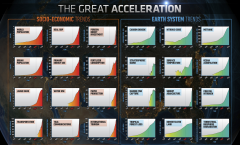
Humanity has become the dominant force of change on Earth, surpassing in importance the geophysical forces that up until now have shaped the biosphere.
In this new geological epoch ~ often called the Anthropocene ~ a profound new risk has been added to the conventional concerns of dwindling resources and local pollution: human action could push the Earth system to abrupt and irreversible shifts of the planetary ecosphere. The repercussions could prove calamitous at local, regional, and global levels.
The Great Acceleration
If humanity continues on its current trajectory, it will likely be unable to meet the needs of a world population that is expected to reach at least nine billion by 2050.
Building on decades of advancements in Earth system science, the planetary boundary (PB) approach offers a framework for keeping world development within a safe operating space. PB analysis relies on the latest research to define tolerance levels of environmental processes that regulate the stability of the Earth system. The first PB analysis was published in 2009 after a two-year research and consultation exchange among global change scientists.
In the latest findings, the original nine PBs remain germane. At the same time, the revised analysis includes several improvements. Chemical pollution has been renamed “introduction of novel entities” to include the release of radioactive materials and nanomaterials. The biodiversity boundary (referred to now as “biosphere integrity”) now has two dimensions: genetic diversity (as before) and functional diversity (using the “biosphere intactness index,” a measure of species abundance). The land use change boundary now considers minima for rainforests, temperate forests, and boreal forest cover, instead of the original proxy of maximum cropland. The nitrogen boundary has been extended to include human-induced reactive nitrogen from modern cultivation. The phosphorous boundary now has two definitions: one for oceans (the original boundary), the other for freshwater systems. Finally, the uncertainty range for the climate change boundary has been narrowed to 350 to 450 ppm CO2 (from 350 to 550 ppm CO2). The new analysis, furthermore, treats climate change and biosphere integrity as “core boundaries”, high-order manifestations of how breaching the other boundaries by can disrupt the Earth system.
With these refined metrics, the analysis concludes that four out of nine boundaries have been transgressed (depicted below). Two are in the high risk zone (biosphere integrity and interference with the nitrogen and phosphorous cycles), while the other two are in the danger zone (climate change and land use change).
Planetary Boundaries
The world thus urgently needs a great transition that rapidly bends the curve of negative global environmental change. Such a turn toward sustainability demands a deep shift in the logic of development away from the assumption of infinite growth toward a paradigm of development and human prosperity within Earth limits. It will require transformations in energy systems, urban development, food systems, and material use. Achieving all this will entail fundamental institutional changes in economic arrangements, financial systems, and world trade.
Transforming the paradigm of world development to prosperity within planetary boundaries depends on a fundamental shift in values, as humanity faces the unprecedented challenge of needing to share the finite global budgets circumscribed by planetary boundaries. To achieve even local aims, the combined effects of local action must conform with globally-defined sustainability criteria established by appropriate governance structures.
The vision here posits a two-track approach. The fast track would operate within the current obsolete development paradigm through a series of global policy measures to nudge our dangerous trajectory away from the most immediate risks. This alone, however, will not suffice. The longer track of a Great Transition will entail a profound mind shift toward universal values that reconnect world development with a resilient Earth, recognize the right of all to development, and promote a shift from materialistic lifestyles to the pursuit of well-being and fulfillment.
Agricultural practices are implicated in almost all planetary boundaries, as agriculture is the largest single emitter of greenhouse gases, the largest single user of freshwater, a major trigger of biodiversity loss, and the main cause of nutrient loading and chemical use. A transformation to sustainable and resilient food systems that integrate water, land, and ecosystems in ways that guarantee the right of all to sufficient, safe, and nutritious food is both necessary and increasingly possible. Sustainable intensification—combining technologies, system improvements, and integrated land-water-nutrient management—can go a long way toward closing the yield gaps between current levels and those possible through ecological farming.
Our current economic logic no longer works, as we confront potentially infinite costs at the planetary scale, rendering concepts like “externalities” and “discounting” useless. The nation-state becomes questionable as a useful unit for wealth creation when policy at the local level depends on regional and global actions and feedbacks. Governance shifts upwards in scale, but still needs rooting and interaction across scales. Sharing finite planetary budgets will require fundamental value changes. Planetary regulation needs to spur innovation and technological breakthroughs. Ethical norms need to evolve to embrace a universal belief that all citizens in the world have the right not only to an equitable share of the available environmental space, but also to a stable and healthy environment. No facet of contemporary society will be unaffected by the Anthropocene.
The window for a prosperous future for humanity on a stable planet remains open, if just barely. We have not yet tipped the planet away from its Holocene equilibrium. Whether we are able to navigate the world back into a safe operating space, thereby creating a chance for a world of nine to eleven billion co-citizens to live and thrive, is up to us. In the Anthropocene, we are in the driver’s seat.
Re~Post: Bounding the Planetary Future: Why We Need a Great Transition | Great Transition Initiative
